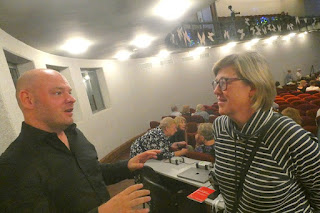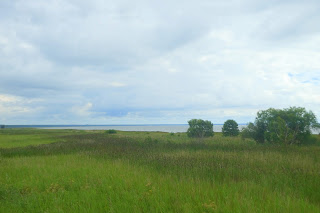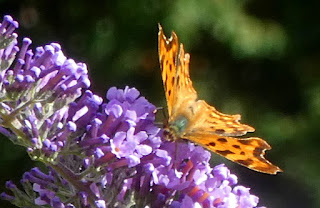To call it 'the Hungarian War and Peace' doesn't do justice to Miklós Bánffy's three-volume chronicle about politics and the aristocracy in the decade leading up to the First World War: it is of equal fascination in the nuancing of its characters, that very Tolstoyan way in which we find sympathy even for those who start off as dislikable. It has a special value in that the Count lived through all this and, writing from the perspective of the 1930s, pours much of himself into the main character, Balint Abady.

Like Abady, Bánffy had diplomatic experience before he became an independent member of the Hungarian House of Representatives, fighting for the rights of the Romanian-speaking population in his native Transylvania. At the time of the novel, 1904-14, Transylvania was part of Hungary; after it, part of Romania. Between the wars, Bánffy made a crucial contribution to his shattered country's reappearance on the world stage as Foreign Minister from 1921-2 and later resettled on his home estate, Bonczhida (Denestornya in the novel); in 1945 the retreating Germans trashed it. I understand that with the Bánffy family's assistance, it's being gradually restored, but even the shell is fascinating (Bonczhida Castle pictured below in 1893-4). Nearby Kolozsvár, now Cluj-Napoca, is also described in loving detail.

With its three subtitles taken from the 'writing on the wall' episode in the Book of Daniel which ends with the downfall of sybaritic Belshazzar, the trilogy can seem forbidding before you start reading - and then, in the very first chapter, Bánffy sweeps us straight into the world of the doomed aristocratic milieu as young Abady finds his carriage one among many heading for Var-Siklod, the country place of Count Lacock who's holding a house party following the Sunday races at Vasarhely. With incomparable vividness Bánffy introduces us to many of the main characters, expanding upon their behaviour in the following chapters devoted to the house-party. The first two volumes especially teem with vivid descriptions of hunting meets (to shoot foxes and hares), balls and other social extravaganzas. Bánffy doesn't intrude too much with authorial judgment, but we know he's telling us that so much of this is TOO much. They're paralleled with sensitive evocations of the beautiful countryside and the mountains: time for a visit next spring.

Parallel to this is the charting of Abady's growing social conscience, his observations of a parliament in Budapest obsessed with matters of local and national interest only. The wider European picture only really emerges when Balint learns of it from a cynical political operator, Hawlata, well in to the second volume: 'at that time [1907] no one believed in the possibility of war in Europe. Everyone accepted that the race for armaments was just a device of the great powers which was nothing more than a safety-valve used to save everyone's face'. A placid patriot up to this point, 'it hurt him to hear such a low opinion of his countrymen coming from a foreigner'. Part Two Chapter Six ends with a breathless Abady at the window of his room, wondering 'what price would be paid by his own country, by Hungary, and by his beloved Transylvania which had always stood as a proud fortress on the road from Rome to Constantinople?' He looks down on the distant light of a train passing through the Vag valley and realises
That would be the road down which would go so many of the flower of the nation's youth to the horrors of war, to their death in battle...and against such a vast enemy their sacrifice would surely be in vain...in vain...
The very last chapter of They Were Divided sees the nightmare come to pass in a nihilistic (or realistic) epilogue, as Abady, defeated in his personal as well as his public life, curses his generation and his people. Among others,
He saw before him the magnates and noble families, who thought only of social prominence, who forgot their European affiliations and threw the weight of their great fortunes and moral influence behind all that nationalistic nonsense of which they did not believe a word and which, in consequence, had poisoned the nation's politics...
Now this land would perish, and with it that deluded generation that had given importance only to theories, phrases and formulae, that had ignored all reality, that had chased like children after the fata morgana of mirage and illusion, that had turned away from everything on which their strength was based, that denied the vital importance of power and self-criticism and national unity.
One virtue alone remained: the will to fight.
And that too would prove in vain.
A truly great novel, though, stands not by the power of its rhetoric but by the living, breathing complexity of its characters, and here Bánffy yields nothing to Tolstoy in detail and shifts of register. The author makes us aware of his alter ego's weaknesses - we follow his early attempts at speechmaking with concern - while making sure that Abady holds the moral compass. The other main character is his cousin László Gyerőffy, a young man of potential genius as a musician who throws it all away on gambling and a dissolute life due to a fatal weakness of character stemming from his early orphaned state. Surely we all know someone like this, someone with friends who want to help him (or her) but ultimately prove powerless. In Book Two, there's a very moving and unexpected scene between László and the outwardly crabby 'Crookface' Kendy, who determines to help the dead-drunk young man because he remembers his irredeemable second cousin Daniel being in the same state.
The psychology of László's angry defensiveness and his surprise capitulation is masterly, but the most moving words belong to 'Crookface': 'There isn't enough love in the world for anyone to throw it carelessly away'. But László does, every time. And it's in connection with his capacity for destroying others that the two strongest women in the novel make their mark. First is the ravishingly beautiful Countess Fanny Beredy, puma-like in her movements, who has musical talent to equal the man with whom she falls in love, resourcefulness and a fascinating personality. László's pride ruins both their lives; incapable of loving anyone else, Fanny's only realm of power remains in wielding what influence she can as the mistress of various powerful men - though Banffy makes it clear that she doesn't hold all the cards. Her disappearance half way through the saga is very troubling; we expect her to re-emerge, but she doesn't, and I wonder if the mysterious benefactor who keeps the destitute László going for as long as possible is supposed to be Fanny. But we never find out. This portrait by Jozsef Rippl-Ronai isn't quite how I imagine Fanny, but it has elements.

Another woman's Calvary, as Bánffy puts it, with even more of a 'don't do it' on our part when faced with László's ongoing self-destruction, is placed in the personage of handsome and independent Sara Lazar, farm manager and better at it than most men in the district. Bánffy's chronicle of how she comes to help the once again degraded youth out of practical sympathy, and falls in love with him, is infinitely nuanced and touching. We think it doesn't have to end badly. But Gyerőffy's character ensures there can be no happy ending.
Alongside Fanny and Sara, the great love of Balint's life, Adrienne Miloth, cuts a less consistent picture. Banffy is frank about sex, and rape within wedlock, which makes the early stages of Adrienne's miserable married life very shocking. And her Mephistophelian, perverse husband Pal Uzdy doesn't always behave quite as one expects - this is another of those complex portraits at which Banffy excels. But even though she's modelled in part on a Bánffy muse, Carola Szilvássy (pictured below), Adrienne remains a frustrating and elusive figure - perhaps that's half the point.

The big set-pieces tail off in They Were Divided, and this is no doubt deliberate: the rapid unfolding of events leading to war overshadows everything, though there are two brilliant narratives which bring a kind of light relief - the ridiculous circumstances of a duel challenge resulting from a spat between two comical Anglophiles at a reception for the French Prince Gaston d'Orleans promotion of his anti-duelling league, and the ridiculous Pityu Kendy's 'execution party' for Brandy, which amuses Balint and then disgusts him as the epitome of Hungarian fatuousness. The political disquisitions mount, making the final volume a different kind of book; but I'm sure Bánffy intended no less.
If the author was unlucky to be neglected under Communist rule, the endless hard work of his daughter Katalin Bánffy-Jelen and Patrick Thursfield in translating it all has to be acclaimed as a miracle - without them, so many Bánffy admirers would know nothing of his genius. It's fascinating to find references to his diplomatic and artistic lives which minimise the 'writer' aspect. But even Bánffy's surprising championship of Bartók's ballet The Wooden Prince and opera Bluebeard's Castle as Intendant of the Hungarian State Theatres is underdocumented, at least in English. Scenarist and librettist Béla Balázs has a very caustic style in his recollections of Bartók for the composer's 60th birthday, but concedes that the Count was 'a talented and intelligent man, and painted lovely scenery'. I suspect you have to go to Budapest to look in the Raday Library for these designs; the only photos I could find were in a lively piece of Banffyana on the website of the tour company Reality & Beyond: I hope the link is enough to reproduce these two images, for what it isn't clear, but the landscape could well be for The Wooden Prince.


A biography of the great man in English is clearly overdue. Thanks to the indefatigable work of Bánffy-Jelen and Thursfield, though, we do have two substantial chunks of memoirs which take us beyond where the novels stop, From My Memories (1932) and Twenty-Five Years (1945). It seems cruel to have gathered them together under the title The Phoenix Land, because Bánffy makes it clear in his introduction to the latter how 'the annihilation that the second catastrophe Fate has brought down upon us is infinitely worst than the first'. He died in 1950, and would be horrified anew at the cynical manipulation of nationalism to feed prejudice that continues under Orbán's ever more disastrous 'Führerdemocracy'.

There's a queasy parallel between the two sets of memoirs. The first begins with Bánffy's imaginative role, as theatre intendant, in creating the spectacle of the last Habsburg coronation in 1916, right in the middle of the First World War. The second includes the comic-operetta haplessness of 'King' Carl's first attempted putsch within Hungary, and the potentially lethal consequences of his second, which could easily have seen Bánffy and others executed had it succeeded (fortunately the vanity and weakness of this impossible creature put fatal delays in the way of a proper Budapest siege, and as Bánffy points out, the Czechs and Romanians would have invaded immediately). I still see Habsburgists waxing lyrical over this coronation without any thought for what the pathetic Carl became. Anyway, it was Bánffy's theatrical instinct to swathe the entire Coronation Cathedral in deep red.

There is some comedy in Bánffy's descriptions, but Part Two of 'From My Memories' turns dark as revolutions threaten his country and he finds himself first trapped in Berlin just as the Spartacist uprising begins, then not too unpleasantly marooned in The Hague, where he turns his hand to portrait painting (plenty more humour here). His most important time as a politician, detailed in Twenty-Five Years, follows the fall of Béla Kun's communist regime, when he serves as Foreign Minister to the honourable István Bethlen, trying to minimise the damage done by the Treaty of Trianon. There's a totally dazzling character sketch of Bethlen adapted from an article originally in the Nouvelle Revue Française, comparing his political emergence to the evolution of life on earth from amphibians to four-legged mammals. I'd love to quote it in full, but I'll let you have the pleasure of seeking it out. At any rate Bánffy also turned out to be a first-rate caricaturist during his time at the 1922 Genoa Conference; it's frustrating not to find more than a couple of reproductions online, and no version of the book subsequently produced, but this is his Bethlen

and this Maxim Litvinov of the Russian Delegation, the arrival of which had all nations holding their breath.
I find it fascinating that my other polymathic, complex discovery of the year, Count Harry Kessler, whose diaries I should have tried to encapsulate here, overlaps with Bánffy at the Genoa Conference. Both give equally vivid impressions of the charismatic Lloyd George especially. Both also had so much in common, balancing diplomacy with their many cultural interests, both fluent in other European languages. Bánffy encapsulates the essence of good diplomacy: always tell the truth in what you actually say - what you don't say is also important - and the essential maxim that 'if one is to confer successfully with foreigners, it is essential to know their way of thinking and be able to put oneself in their place'. Working so assiduously with slippery characters, though, brought him to the edge of a nervous breakdown.

In a way I wish Bánffy had kept diaries like Kessler, but the 'Red Count', as the latter was called in a much more dramatic volte-face than the Hungarian's flexible sympathies, wasn't entirely honest, so it comes to more or less the same thing. Kessler left us another important legacy, but Bánffy's must be seen as the greater literary figure, creating a masterpiece on a level with Tolstoy and Lampedusa. And so readable - when I announced that I'd picked it up halfway through Vol. 2 in hospital, some were concerned that I wasn't going in for lighter material. But I was soon in that world again. I urge you to go for total immersion - once you start, you should be hooked.




















































































